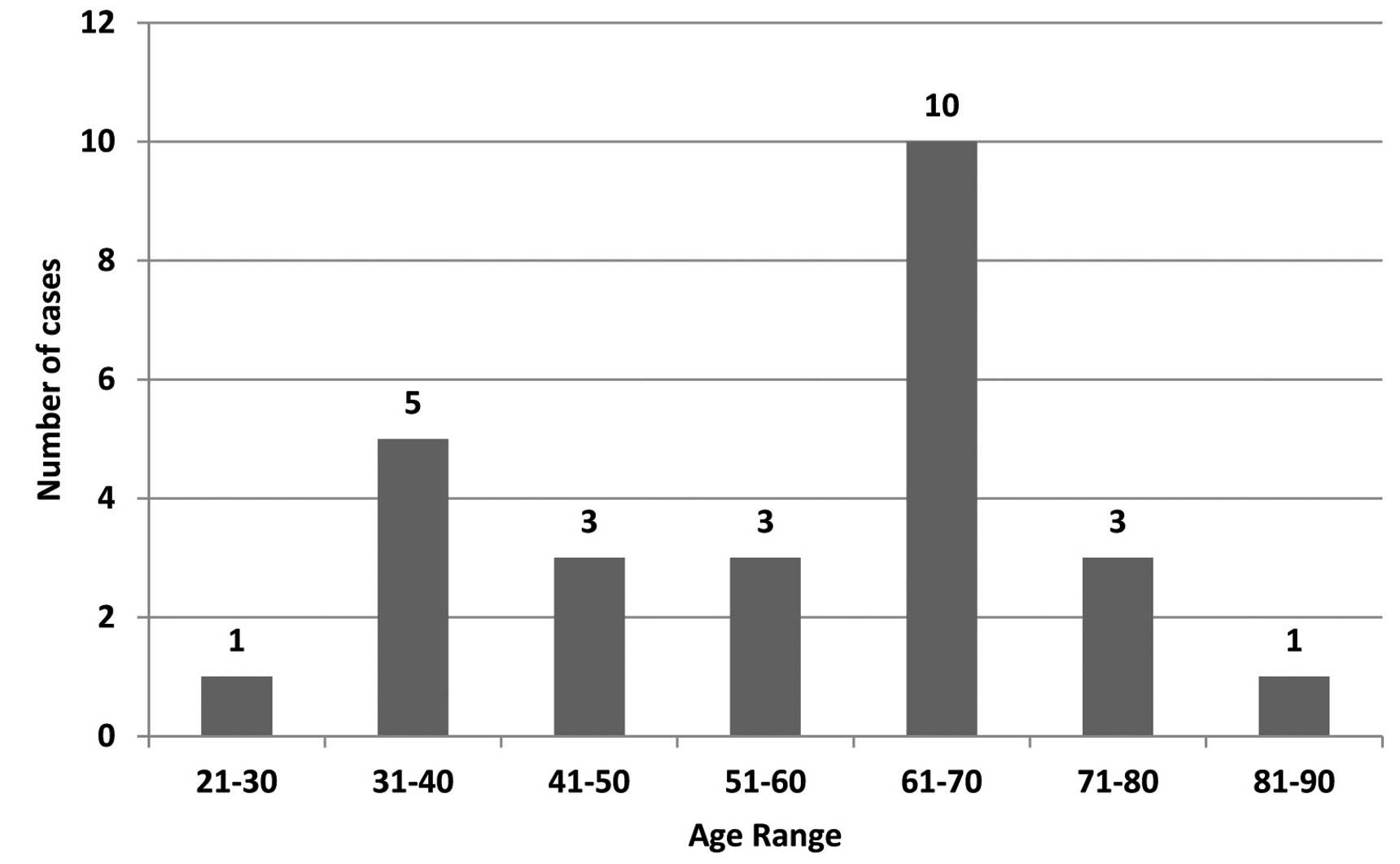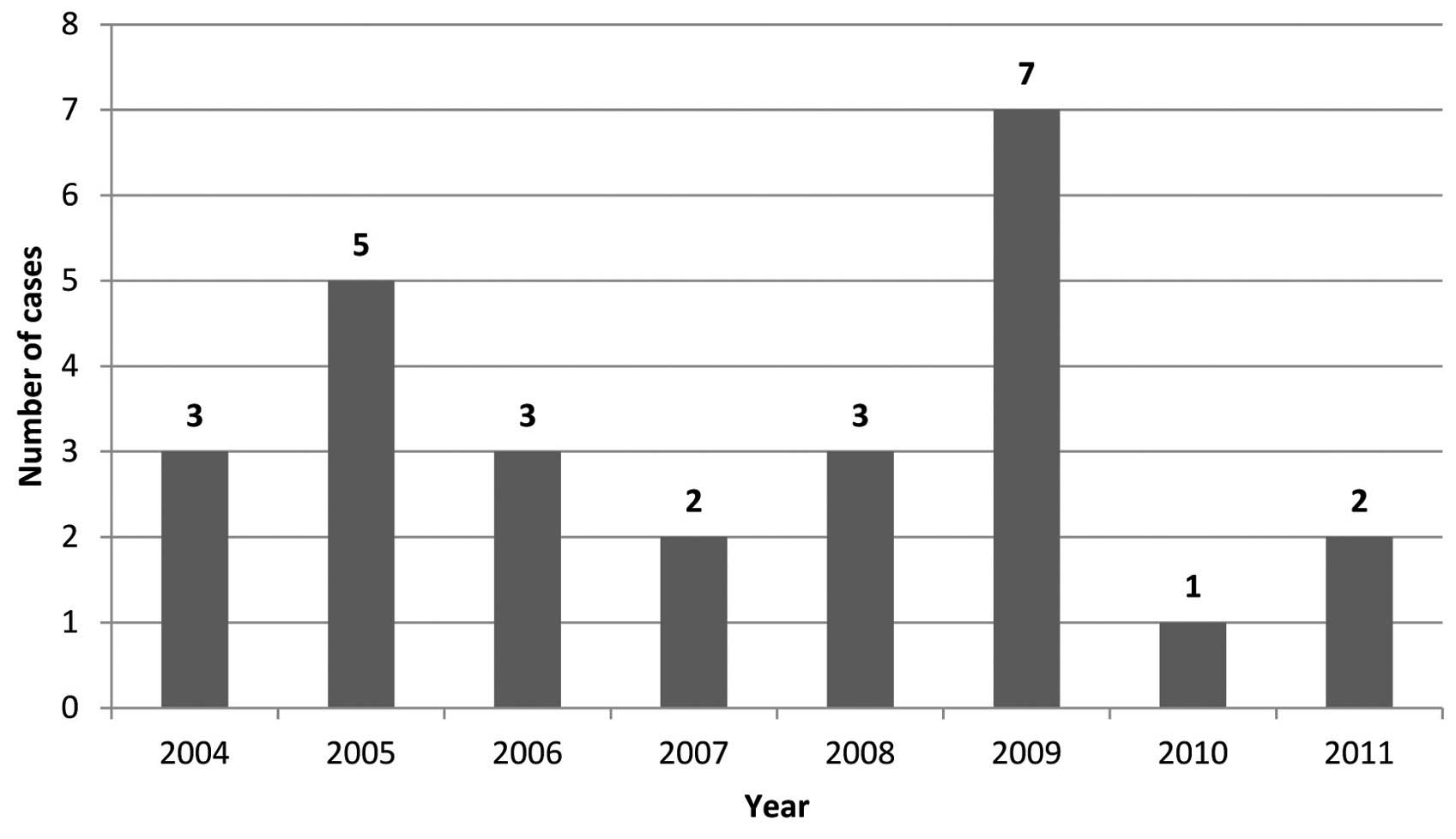Introduction
The estimated global annual incidence of oral cancer
is 275,000 cases, with a higher incidence in developing countries
and >90% classified as squamous cell carcinoma (SCC) (1). Clinical presentation includes a
persistent red or white patch, a sore throat or a chronic ulcer.
There may also be pain upon swallowing and unexplained otalgia.
Associated causes include tobacco use and the human papilloma
virus. The basis of treatment includes biopsy to confirm the
diagnosis, followed by surgery, radiotherapy and chemotherapy.
Lymph node neck dissection is necessary in all cases. Tongue SCC is
the most prevalent type of oral cancer, accounting for 25–40% of
oral SCCs (2). The 5-year survival
rate of tongue cancer is 78% for local spread, 63% for regional
spread and 36% for distant spread according to the American Cancer
Society (3). Trinidad and Tobago
are the southern-most islands in the Caribbean sea, adjacent to the
coast of Venezuela, and are composed of a diverse mix of
ethnicities, including individuals of Indian descent (40%), African
descent (38%), mixed ethnicity (20%) and individuals of European,
Chinese and Arabic descent (2%). At present, no epidemiological
data exists for tongue SCC in Trinidad and Tobago and the West
Indies. Therefore, the present study was conducted to provide data
on this rare but preventable malignancy.
Patients and methods
Data collection
Retrospective data regarding all cases of tongue
histology were collected from the electronic records of the
Department of Pathology at the Port of Spain General Hospital
(POSGH; Port of Spain, Trinidad and Tobago) from the period between
October 2003 and February 2012. Data included information regarding
the date of collection, patient age and gender, department and
hospital of origin, details of the morphological appearance of the
specimen, and histological diagnosis. The data included patients
from the following hospitals: The POSGH, the Sangre Grande District
General Hospital (SGH) and the Scarborough Regional Hospital (SRH),
which are the main referral centres in Trinidad and Tobago, serving
a catchment area of ~700,000 individuals and managing the majority
of complex tumour cases.
Statistical analysis
Demographic and epidemiological tongue carcinoma
data were analysed using IBM SPSS software version 20 (SPSS, Inc.,
Armonk, NY, USA) and comparisons were made with previously
published worldwide and regional data. Ethical approval was granted
from the North West Regional Health Authority (Port of Spain,
Trinidad) to collect and analyse the data.
Results
Between the study period of October 2003 and
February 2012 (101 months), 118 tongue lesions were biopsied. Of
these, 26 cases of tongue carcinoma were identified, including 21
cases in males (81%) and five in females (19%). The age range was
29–86 years, with a mean, median and mode of 57, 62 and 66 years,
respectively. Furthermore, the most common group affected was the
61–70 years age group (Fig. 1). The
number of newly diagnosed cases per year ranged between one and
seven, with an average of 3.25 new cases/year and a peak of seven
new cases in 2009 (Fig. 2).
Analysis of ~700,000 individuals over an eight-year period was used
to calculate the incidence rate of tongue carcinoma in Trinidad and
Tobago as 0.46 per 100,000 individuals/year. In terms of the
hospital of origin, 25 cases were from POSGH (96%) and one case was
from SRH (4%); no cases occurred at SGH.
Histological analysis of the 19 cases in which the
degree of differentiation was recorded, revealed that the extent of
differentiation was distributed as follows: Five cases (26%) of
poorly-differentiated SCC, eight cases (42%) of
moderately-differentiated SCC and six cases (32%) of
well-differentiated SCC. The extent of differentiation was not
documented in seven of the cases. In addition, there was one case
in which the patient presented with a chronic inflammatory process.
There was also one case of mucoepidermoid adenocarcinoma of the
tongue in a 57-year-old female originating from POSGH.
Discussion
Oral cancer is the sixth most common type of
carcinoma globally, with an estimated annual incidence of 275,000.
It is known to occur more frequently in developing countries and
>90% of carcinoma cases in developing countries are classified
as SCC (1). It is estimated that
carcinoma of the tongue accounts for 25–40% of all SCC lesions
(2) and occurs more frequently in
developing countries (1), with wide
geographical variation. There is a documented high incidence of
tongue carcinoma in South and Southeast Asia (Sri Lanka, India,
Pakistan and Taiwan), parts of Western Europe (France), Eastern
Europe (Hungary, Slovakia and Slovenia), parts of Latin America and
the Caribbean (Brazil, Uruguay and Puerto Rico) and Pacific regions
(Papua New Guinea and Melanesia) (1). Furthermore, male incidence rates of
tongue carcinoma in India have been reported at <6.5 per 100,000
individuals per annum, with corresponding rates in France of
<8.0 per 100,000 individuals per annum (4). It is important to analyze the
differences in order to make comparisons between developed and
developing countries as well as to establish differences and trends
between developing countries in order to determine if other
environmental and economic factors affect the incidence of tongue
cancer.
A recent study performed by Effiom et al
(5) in Lagos, Nigeria, demonstrated
that oral SCC accounted for 10.8% of all tumours biopsied in a
cohort with a mean age of 45 years and a male:female ratio of
1.4:1. In total, 40% of these patients were <40 years old and
the peak incidence was in the 20–29 and 40–49 years age groups.
Poorly-differentiated SCC was the most common subtype of oral SCC
identified (47.6%), followed by well-differentiated (32.6%) and
moderately-differentiated (19.7%) SCC. This is in contrast to the
Trinidadian data of the present study, where the male:female ratio
was closer to 4:1, the peak incidence was in the 61–70 years age
group and moderately-differentiated SSC was the most common type of
oral SCC, followed by well-differentiated and then
poorly-differentiated SCC.
A retrospective study examining the treatment of
tongue cancer between 1996 and 2002 in Mumbai, India (6) identified the most common age range of
presentation as 50–60 years and the male:female ratio as 4:1,
corresponding to the distribution in Trinidad and Tobago. The
majority of cases were oral SCC (98%), with a small number of
mucoepidermoid (1%) and adenocystic carcinoma (1%) cases
additionally reported. Of the oral SCC, well-differentiated SCC
(77.8%) was the most frequent subtype identified, followed by
moderately differentiated (20%) and poorly differentiated (2.2%)
SCC; this is in contrast to the present study, in which moderately
distributed SCC was the most prevalent type, followed by
well-differentiated and poorly-differentiated SCC.
A study of patients presenting to Mexico City’s
General Hospital (Mexico City, Mexico) with oral SCC between 1990
and 2008 (7) identified that 58.4%
of patients were male, as opposed to the 81% male predominance
identified in the present study, thus resulting in a male:female
ratio of 1.4:1. In addition, the mean age was 62.5±14.9 years,
which was higher than the mean age of 57 years that was calculated
for the present study. The tongue (44.7%) was the most common
anatomical region of oral SCC, followed by the lips (21.2%) and
gums (20.5%), while the most frequent histological degree was
moderately-differentiated SCC (61.2%).
A retrospective analysis of patients with oral SCC
of the tongue in Lisbon, Portugal, for the period of 2001–2009
(8) identified that 71% of patients
were male, with a male:female ratio of 2.45:1. The mean age of
occurrence in the male patients was within the fifth decade (58.8
years), corresponding to the mean age of 57 years identified in the
present study, and within the sixth decade (65) for females. In
addition, the peak incidence of tongue carcinoma was within the
61–70 years age group for males and females, similar to the present
study.
A recent study of SSC of the oral tongue (OTSCC),
the base of the tongue and the tonsils in the United States
(9) identified that 58.6% of OTSCC
cases occurred in males and 41.4% occurred in females, with a
male:female ratio of 1.42:1. The peak incidence of OTSCC was 60–79
years (45.2%), in agreement with the peak incidence age group of
61–70 years identified in the present study, followed by 40–59
years (36.3%).
In conclusion, the incidence of tongue carcinoma in
Trinidad and Tobago is low in comparison to other regions, which
may be due to the fact that tobacco chewing is rare in this region,
and the incidence has with a male to female ratio of 4:1 with 96%
of cases classified as SCC. In the present study, the peak
incidence was found in individuals aged 61–70 years, with an
overall incidence of 0.46 per 100,000 individuals per annum. These
findings are in agreement with certain previously reported global
data, with no detectable differences identified between ethnic
variations in Trinidad and Tobago. Additional studies are required
to determine if the differences identified are due to the
limitations of the sample size, and closer analysis is required to
identify the risk factors and outcomes of surgery for the treatment
of tongue carcinoma in Trinidad and Tobago. The present study adds
previously unreported data to the regional and world dataset and
may serve as a platform for additional research on the topic.
Acknowledgements
The present authors acknowledge the work of the late
Dr Neville Jankey, Consultant Pathologist at the General Hospital
(Port-of-Spain, Trinidad and Tobago) and one of the main
contributors to this database.
References
|
1
|
Warnakulasuriya S: Global epidemiology of
oral and oropharyngeal cancer. Oral Oncol. 45:309–316. 2009.
View Article : Google Scholar
|
|
2
|
Kokemueller H, Rana M, Rublack J, et al:
The Hannover experience: surgical treatment of tongue cancer - a
clinical retrospective evaluation over a 30 years period. Head Neck
Oncol. 3:272011. View Article : Google Scholar :
|
|
3
|
American Cancer Society. Survival rates
for oral cavity and oropharyngeal cancer by stage. http://www.cancer.org/cancer/oralcavityandoropharyngealcancer/detailedguide/oral-cavity-and-oropharyngeal-cancer-survival-rates.
Accessed December 21, 2014
|
|
4
|
Moore SR, Johnson NW, Pierce AM and Wilson
DF: The epidemiology of tongue cancer: a review of global
incidence. Oral Dis. 6:75–84. 2000. View Article : Google Scholar : PubMed/NCBI
|
|
5
|
Effiom OA, Adeyemo WL, Omitola OG, et al:
Oral squamous cell carcinoma: a clinicopathologic review of 233
cases in Lagos, Nigeria. J Oral Maxillofac Surg. 66:1595–1599.
2008. View Article : Google Scholar : PubMed/NCBI
|
|
6
|
Kazi RA: Carcinoma of tongue: A
retrospective study of 110 cases. Internet J Otorhinolaryngol.
2:22003.
|
|
7
|
Hernández-Guerrero JC, Jacinto-Alemán LF,
Jiménez-Farfán MD, et al: Prevalence trends of oral squamous cell
carcinoma. Mexico City’s general hospital experience. Med Oral
Patol Oral Cir Bucal. 18:e306–e311. 2013. View Article : Google Scholar
|
|
8
|
Albuquerque RP, López-López J, Jané-Salas
E, et al: A pioneering epidemiological study investigating the
incidence of squamous cell carcinoma of tongue in a Portuguese
population. Med Oral Patol Oral Cir Bucal. 17:e550–e554. 2012.
View Article : Google Scholar : PubMed/NCBI
|
|
9
|
Saba NF, Goodman M, Ward K, et al: Gender
and ethnic disparities in incidence and survival of squamous cell
carcinoma of the oral tongue, base of tongue, and tonsils: a
surveillance, epidemiology and end results program-based analysis.
Oncology. 81:12–20. 2011. View Article : Google Scholar : PubMed/NCBI
|
















